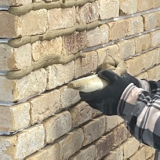
We always seem to talk extensively about brick slips on here, and why not ! we live, sleep and breathe these wonderfully beautiful slim slices of clay. As with any product that has deep and meaningful routes we would like to dedicate this post to the origins of brick manufacturing. Without bricks we wouldn’t have brick slips.
Here at brickslips we love bricks just as much as we love brick slips.
Often taken for granted, bricks are vital to the makeup and construction of the developing world. They have been manufactured and used for thousands and thousands of years.
Where were the first bricks made?
Mankind has always had the natural urge to build. Buildings and safe bases are written into the fabric of human DNA. Bricks and clay blocks have been manufactured since at least 7000 years before Christ. This fact alone makes them the oldest produced and manufactured building material on the planet.
The first manufactured bricks were made in areas of advanced civilisation and where the warmer climates were. The Turkish, Persians, romans and Aztecs were just some of the early civilisations which initiated full manufacturing of clay based bricks.

These early bricks were sun dried and often mixed with straw and timber strands to help them hold their form during the drying process.
This early form of brick paved the way for a global breakthrough in brick manufacturing. By 3,500 bc the Romans had devised a system of drying and firing the bricks to a high temperature. This ingenious new method using kilns brought a stronger and more durable product and also made the process possible in colder environments. Some say that bricks production was a major factor in the Romans ability to be able to expand their empire across the globe.
Mass production throughout Europe
During the growth and spread of the Roman Empire, the amount of brick making increased to levels of major mass production. Slaves were brought in from all corners of the globe to keep up with the demand. Every lieutenant wanted a villa in each of the countries they conquered, whole cities were created for the passage of troops and trade. Bricks helped to spread the Romans art form well into the medieval and pre renaissance periods.
Eventually like most great civilizations, the Roman Empire fell, and with it the age old art of making bricks pretty much died with the Romans. Small pockets of brick makers remained in what then became Italy, and the trade laid dormant until the French resurrected the art form in the 11th century.
The 12th century saw brick manufacturing reintroduced to eastern Europe and from then the surge in Gothic architecture was built using real clay kiln fired bricks. This amazing sweep of style has tourists flocking to these areas every year. Buildings still standing from a period of great brick manufacturing.
How were bricks manufactured?
The main method of hand making bricks hasn’t changed that much over the years. Back in the Middle Ages bricks would be kneaded and then formed by moulding the clay into a wooden pre made form. The forms would be lined with either sand or grass/straw. Excess clay would then be scraped off using a wire and the form would be flipped and the brick created.
Many buildings that form part of some of the UK’s oldest cities are lined with buildings which have these early handmade bricks.
The Industrial Revolution and Brick Manufacturing
Bricks were almost exclusively hand made up until the industrial revolution.
The very first successful brick manufacturing machine was invented and patented by Henry Clayton of Atlas Brick Works in Middlesex, England, in 1855. This landmark invention was able to produce up to 25,000 bricks per day.
This influx and increased capacity for production meant that housing, social housing and developments could be built quicker and cheaper.

As an obvious reaction to this new revolution the UK saw a dramatic increase in building and the 19th century saw massive projects being undertaken.
Modern Day Brick Production
Fast forward to modern day, new technologies have meant that production of bricks is in its highest demand. Advances on the traditional methods mean that most brick works run automated brick extrude lines, and have kilns which run constantly.
This mass scale production still doesn’t produce enough bricks for the UK market. Bricks are now brought in from all over Europe as a way of meeting demand.

Due to the history of brick manufacturing, the trial and errors which have taken place for thousands of years. We can safely say that modern day production benefits greatly from the evolution of this great industry.
Modern brick works give a great choice, producing products with varied surface textures and a rich diversity of colours. Advancing the creation of new innovative structures and allowing credible brick-matching when working with existing builds.
































